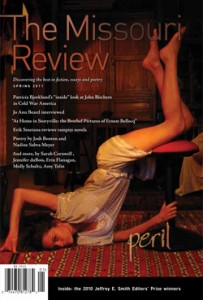The first time you walk the floor of AWP, don’t feel bad for thinking you’ve stumbled onto some kind of literary flea market. It isn’t just the labyrinth of tabletops and booths, the proximity of publishers and agents to literary journals and MFA programs—it’s how all of us look so truly broke.
Which we are, of course. Half of us non-profits, the other half of us profitless, the floor is a litter of bookish bargains: journals and back issues, all hocked at severely-reduced prices; subscription rates written out on crinkled pieces of construction paper; the occasional t-shirt for sale, a scheme from which FWR cannot claim innocence.
A Comic-Con for writers, an E3 for readers, AWP is governed by the same set of bylaws that make conventions worthwhile for attendees who’d rather spend their cash at the bar: Giveaways Rule.
 Which is how I, in a frantic sprint around this year’s convention floor, met The Missouri Review. A friend had just told me the name of a story I had to read and with trusty cell phone dead, I was in need of a pen—the one thing you’d think a room of writers could provide.
Which is how I, in a frantic sprint around this year’s convention floor, met The Missouri Review. A friend had just told me the name of a story I had to read and with trusty cell phone dead, I was in need of a pen—the one thing you’d think a room of writers could provide.
But The Missouri Review didn’t just give me a pen. They gave me a handy, branded notebook to write in. And afterward, they gave me their Winter 2010 issue. Besides being unexpected, all of this was totally free and totally uncalled for, and in my head, I officially awarded The Missouri Review with “Best-in-Show” for their selflessness. Of course, I couldn’t have known the issue in my hand would overshadow all of this.
 The issue—Volume 33, No. 4—first got my attention with an interview with Michael Byers, an author we’ve interviewed here on FWR and one we are proud to call a contributor. Reading Michael’s interview in The Missouri Review was like seeing a friendly face amidst the masses at AWP. Instantly at ease, I kept reading. First came Dan Stolar‘s “Emma Won’t Get Better” and its depiction of how even the happiest families can collapse in the face of tragedy; then came Karl Taro Greenfeld‘s “Even the Gargoyle is Frightened,” the shocking story of a Japanese naval officer’s dark investigation into a pilot’s murder.
The issue—Volume 33, No. 4—first got my attention with an interview with Michael Byers, an author we’ve interviewed here on FWR and one we are proud to call a contributor. Reading Michael’s interview in The Missouri Review was like seeing a friendly face amidst the masses at AWP. Instantly at ease, I kept reading. First came Dan Stolar‘s “Emma Won’t Get Better” and its depiction of how even the happiest families can collapse in the face of tragedy; then came Karl Taro Greenfeld‘s “Even the Gargoyle is Frightened,” the shocking story of a Japanese naval officer’s dark investigation into a pilot’s murder.
A suitcase full of back issues and first-prints and I’d gotten all this free? It seemed preposterous, and only became more so as I learned about The Missouri Review’s pedigree. Recognized by Best American Short Stories, Best American Essays, Best American Poetry, New Stories From The South, and The Pushcart Prize, The Missouri Review has, for over thirty-four years, published four issues a year—issues I quickly realized I was lucky to have received.

McReynolds Hall
With over 13,000 submissions a year, The Missouri Review has likely penned a few potentially famous rejection letters itself. But with an editorial focus on mining the submission pile for new talent, the journal reads year-long and the list of accomplished writers it has published reflects that. The trend is traceable—established authors like Joyce Carol Oates and Amy Hempel beside debut authors like Nathan Hogan and Susan Ford; David Foster Wallace beside newcomer Jennie Lin.

Michael Nye
What is the role of The Missouri Review in today’s literary community, be it for readers or writers?
In some ways, our role has never changed: discover and publish the best writing, regardless of the author’s reputation. That is crucial: we don’t publish writers, we publish writing. For writers, we are well-known for being outstanding editors of manuscripts (Ryan Harty, whose work appeared in volumes 25 and 26 of The Missouri Review, called Evelyn Rogers the best editor he has ever had) for our prose pieces. For poets, we showcase a minimum of three poems, often more, from a single poet, which gives our audience the opportunity to experience a series of poems rather than just one, which is often the case in other literary journals. What we mean by that is that it’s about the work, not the person who wrote it, whether we’re talking about a story or an essay or a series of poems, and we believe that decision is ultimately better for our readers and our writers.
How do you see The Missouri Review’s mission and tastes evolving in the next two years? Will the rise of digital publishing impact the composition of The Missouri Review?
Our taste, while certainly open to new flavors, won’t veer too much from what it has always been: we want to read work that engages us. We aren’t fashionable: that follows trends, like big hair and shoulder pads in the ‘80s, rather than being distinctive. We think of ourselves as stylish. I’d hate to think that in just two years, we would somehow be incredibly different in terms of the quality and type of work we publish.
If you could put three items in a time capsule (or USB drive) to be opened in 1,000 years, that would provide a snapshot of The Missouri Review’s aesthetic today, what would they be?
Speer loves to ride to work, either on bicycle or scooter, so we’ll throw his best bicycle in the time capsule. The image of the bike seems to fit our aesthetic in a way that I’m going to be coy about and not define better. We’d also include a USB drive of our best Xtranormal videos that showcase our daily operation while simultaneously making fun of ourselves. Finally, we would include a huge batch of Post-It “Pop-Up” Notes because we kinda like treating them like a Slinky. It helps our staff think.
What album is playing on The Missouri Review stereo these days?
This is a surprisingly difficult question: we have over 35 people each semester, which includes our senior staff, graduate editors, and undergraduate interns, so one album is really tough to pin down. I usually go jazz or hip-hop: Giant Steps by Coltrane and Illmatic by Nas are two favorites. The rest of our staff has tons of downloads and playlists: popular around here are The Morning Benders, Tegan and Sara, The Strokes, Jay Electronica, Pinback, and Wale. “Eclectic” sounds like an understatement, doesn’t it?
 Since my experience at AWP 2011, The Missouri Review has published its spring issue. Boasting the winners of their 20th Annual Jeffrey E. Smith Editors’ Prize, the issue contains fiction from Anna Solomon, poetry from Goerge Looney, and an essay by John Hales. All three were in Columbia, Missouri, for the Editors’ Prize weekend, for which interviews are now available on the revamped missourireview.com.
Since my experience at AWP 2011, The Missouri Review has published its spring issue. Boasting the winners of their 20th Annual Jeffrey E. Smith Editors’ Prize, the issue contains fiction from Anna Solomon, poetry from Goerge Looney, and an essay by John Hales. All three were in Columbia, Missouri, for the Editors’ Prize weekend, for which interviews are now available on the revamped missourireview.com.
Launching in a month, the journal’s all-new website will include not only subscriptions, submissions, and back issues, but a blog you’ll enjoy if in need of fresh and irreverent responses to issues in contemporary literature. And as always, we suggest you keep the good karma going by friending them on Facebook and following them on Twitter.
After all, you never know when a free pen giveaway might introduce you to stories you’ll never forget.
As a special bonus to readers of Fiction Writers Review, we’ll be giving away three free subscriptions to The Missouri Review! If you’d like to be eligible for this week’s drawing (and all future ones), please visit our Twitter page and “follow” us.
For those of you already in the FWR Twitter family, you know our presence there exists in part to inform followers of what’s happening here on the site, as well as to update the community on literary trends, worthwhile links, etc. We couldn’t be happier to see this role expand in a way that allows us to put journals we love in the hands of readers who will love them too.



